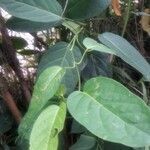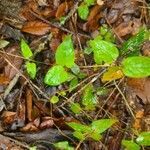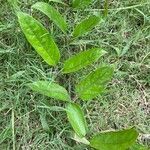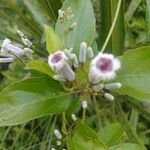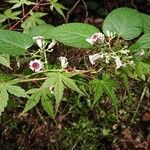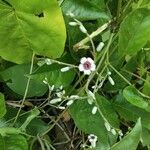Vines, to 5 m; stems glabrous to densely puberulent, hirtellous, or pilosulous often becoming glabrescent, drying gray to brown. Leaves opposite or rarely ternate; petiole 0.5-9 cm, glabrous to densely hirtellous or pilosulous; blade drying papery to subleathery, ovate, ovate-oblong, lanceolate, lanceolate-elliptic, or elliptic, (1-)5-9(-21) × 1-4(-9) cm, adaxially glabrous to puberulent at least on principal veins, abaxially glabrous to puberulent, hirtellous, or strigillose at least on principal veins, base cuneate, rounded, truncate, or sometimes cordulate to cordate, margins flat, apex acute or acuminate; secondary veins 4-6 pairs; stipules generally persistent, triangular to ovate, 1.5-6 mm, obtuse to acute, acuminate, or rarely bifid. Inflorescences axillary and/or terminal, paniculate, thyrsiform, corymbiform, or cymose, pyramidal to rounded, 5-100 cm, branched to 2-5 orders with higher order axes dichotomous or often scorpioid, hirtellous, strigillose, or glabrous, pedunculate; bracts lanceolate to triangular, 0.8-3 mm; pedicels to 1.5 mm. Flowers sessile to pedicellate in dichotomous to scorpioid, lax to somewhat congested cymules. Calyx glabrous to densely puberulent; hypanthium portion turbinate to ellipsoid, 0.8-2 mm; limb deeply lobed; lobes triangular, 0.4-1 mm. Corolla pale purple, grayish pink, lilac, or grayish white, funnelform, outside densely mealy puberulent or mealy tomentulose; tube (5-)7-10(-17) × 2-6 mm, without slits; lobes broadly triangular to ovate, 1-2 mm, acute. Fruit globose, 4-7 × 4-7 mm, glabrescent, drying gray to yellow; pyrenes concavo-convex to plano-convex. Fl. May-Oct, fr. Jul-Dec.
More
A small woody climber. The stems are tough. It is evergreen. It grows 2-4 m high. The plant has fine grey hairs over it. The leaves are opposite and narrowly oval. The leaves are 8-11 cm long by 3-4 cm wide. The leaves have an unpleasant smell when crushed. The flowers are greyish-purple. The fruit are oval or oval and red or yellow.
A ruderal in thickets and woodland, also along forest edges, in secondary evergreen to deciduous forest and clearings in primary forest. Also grows in montane vegetation up to 3,000 m, on steep, forested slopes, or on sandy or rocky sea coasts.
More
A ruderal in thickets and woodland, also along forest edges, in secondary evergreen to deciduous forest and clearings in primary forest. Also grows in montane vegetation up to 3,000 m, on steep, forested slopes, or on sandy or rocky sea coasts.
A tropical plant. It is often near river banks. It climbs over thickets and fences. It also climbs over mangroves. In Indonesia it grows up to about 2,000 m above sea level. In Sichuan and Yunnan.
